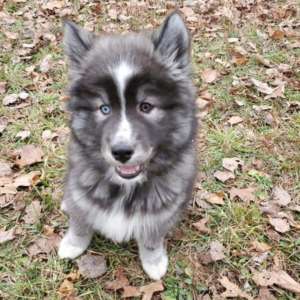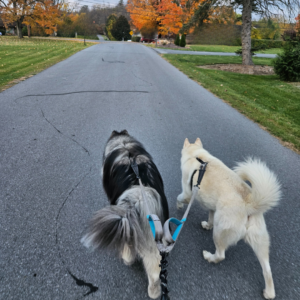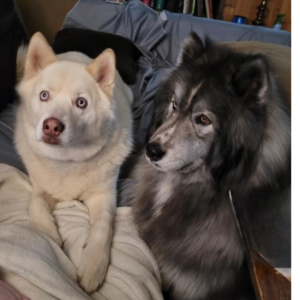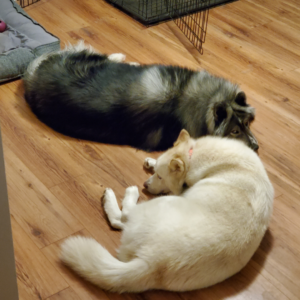I Got a Husky Puppy! Essential Tips for New Owners
- 0 comments
- by Devynn
 Bringing home a husky puppy is an exciting and rewarding experience, but it can also feel overwhelming if you’re not sure what to do next. Huskies are intelligent, high-energy dogs with unique needs, so getting off on the right paw is crucial for a happy and healthy journey together. Here’s a step-by-step guide to help you navigate the early days with your new furry friend.
Bringing home a husky puppy is an exciting and rewarding experience, but it can also feel overwhelming if you’re not sure what to do next. Huskies are intelligent, high-energy dogs with unique needs, so getting off on the right paw is crucial for a happy and healthy journey together. Here’s a step-by-step guide to help you navigate the early days with your new furry friend.
This Post contains affiliate links, meaning I make a commission on products bought at no additional cost to you. Thank you for your Support!
1. Prepare Your Home
Before your puppy arrives, puppy-proof your home. Imagine your baby proofing for a toddler. Huskies are curious and love to explore, so secure anything that could be harmful, such as:
-
- Electrical cords
-
- Small objects that could be swallowed
- Get couch covers
Set up a designated area with a comfy bed, crate, food and water bowls, and toys. I also would wait until they are potty trained to spend money on a bed. Huskies thrive on routine, so establishing a “home base” will help them feel secure. Don’t put the bed or blankets in the crate. Placing these items in the crate can lead to problems, as your dog might use them to bury their poop or tear them apart. This could result in them ingesting something harmful, potentially requiring a vet visit or even surgery. The same applies to dog toys.
2. Begin Training Immediately
Huskies are known for their intelligence but can be stubborn, so early training is essential.
-
- Potty Training: Stick to a consistent schedule, taking them outside after meals, drinking, naps, and playtime. Essentially every hour or two to be safe and consistent. If you want your puppy to learn a specific signal to let you know they need to go outside, start teaching it immediately. Establishing this communication early will make potty training much smoother. Here are some effective signals you can teach:
-
- Bell Training: Hang bells or puppy door bell near the door and gently guide your puppy to touch it with their paw or nose before going outside. Over time, they’ll associate ringing the bell with going out.
-
- Scratch Pad: Place a scratch pad or mat near the door. Encourage your puppy to paw at it before you open the door.
-
- Verbal Command: Use a consistent phrase like “Outside?” or “Potty time” every time you take them out, so they associate the word with the action.
-
- Hand Targeting: Teach your puppy to nudge your hand or a specific object when they need to go out.
-
- Consistency and positive reinforcement—like treats and praise—are key to helping your puppy understand the signal.
-
- Potty Training: Stick to a consistent schedule, taking them outside after meals, drinking, naps, and playtime. Essentially every hour or two to be safe and consistent. If you want your puppy to learn a specific signal to let you know they need to go outside, start teaching it immediately. Establishing this communication early will make potty training much smoother. Here are some effective signals you can teach:
-
- Basic Commands: Start with simple commands like “sit,” “stay,” “leave it” and “come.” Reward positive behavior with treats and praise.
-
- Crate Training: Huskies are escape artists, so a secure crate will keep them safe when unsupervised. Make it a positive space by using treats and toys.
-
- Only get a crate big enough for them to turn around in. This prevents them from using their house as a bathroom. Once they are potty trained it isn’t an issue and they can have a delux crate.
-
- Avoid leaving your puppy unsupervised in the house until they’re much older and have proven they can handle it. Test their behavior gradually by allowing short, monitored periods of freedom while you’re home or even during the night when you’re asleep. This helps ensure they’re ready for the responsibility.
-
- It took my huskies until they were like three years old. Now in my case my 1st husky sky became more trusted once I got my 2nd Koda.
-
- Crate Training: Huskies are escape artists, so a secure crate will keep them safe when unsupervised. Make it a positive space by using treats and toys.
3. Take them to the Groomer Early
-
- Introducing your puppy to the groomer early helps them become comfortable with the process, making future grooming sessions less stressful for both of you. Puppies are more adaptable, so starting young allows them to get used to being handled, the sounds of clippers, and the unfamiliar environment. Early visits also help the groomer address any breed-specific needs, ensuring your puppy’s coat and nails are properly cared for. Building a positive grooming routine from the start sets the stage for a lifetime of good hygiene and health.
———————————————————————————————————————————
4. Socialize Your Puppy
Huskies are pack animals and thrive on social interaction. Early socialization helps them grow into friendly, confident dogs.
-
- Introduce them to other dogs, people, and different environments gradually.
-
- Take them on walks in your neighboorhood, to stores that allow pets and/or send them to doggie daycare.
-
- Expose them to sounds like the vacuum cleaner or doorbell to reduce fearfulness later.
-
- Enroll in a puppy class for structured socialization and basic obedience.
5. Channel Their Energy
Huskies are high-energy dogs bred to run and work, so they need plenty of physical and mental stimulation.
-
- Daily Exercise: Even as puppies, short walks or play sessions are a must. Avoid over-exercising young pups to protect their growing joints.
-
- Interactive Toys: Puzzle toys or treat-dispensing balls keep their minds busy.
-
- Games: Tug-of-war, fetch, or even teaching them new tricks can burn off energy.
6. Nutrition and Health
Feed your husky puppy a high-quality puppy food designed for their size and energy level. Huskies have sensitive stomachs, so monitor for any signs of allergies or digestive issues.
Schedule a vet appointment for a check-up, vaccinations, and deworming. Ask your vet about the best flea and tick prevention for your area.
7. Understand Their Unique Traits
Huskies are not your average dog, and knowing their quirks will help you be a better owner:
-
- Howling Over Barking: Huskies communicate through howls, so don’t be surprised if they serenade you!
-
- Escape Artists: These clever dogs can jump fences and open doors, so invest in secure fencing and watch them closely outdoors. I recommend an electric fence and a physical fence.
-
- Digging: they will dig holes all through your yard.
-
- Independent Streak: Huskies may test boundaries, so consistency in training is vital.
-
- Stubborn: If there is snow on the ground then you may have entice your huskies to come inside with a treat.
8. Build a Bond
Huskies are incredibly loyal and thrive in a family setting where they feel loved and included. Spend time playing, cuddling, and engaging with your puppy to create a strong bond that will last a lifetime.
9. Plan for the Future
Your little fluffball will grow fast! Huskies can be challenging as they transition from adorable puppies to energetic teenagers. Be prepared for the long haul with ongoing training, patience, and lots of love.
Conclusion
Owning a husky puppy is an adventure filled with joy, challenges, and unconditional love. With preparation, training, and a commitment to meeting their needs, your new furry friend will become an irreplaceable part of your family.
Want more husky essentials click here.
Are you ready to embrace the husky life? Let the adventures begin!
Embrace simplicity, live fully, and cherish each day – until next time, Devynn.
Have tips or stories about your own husky puppy experience? Share them in the comments below!



